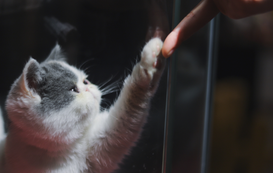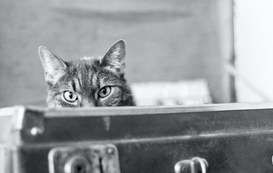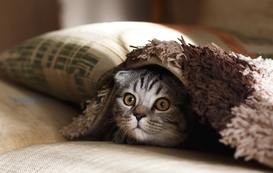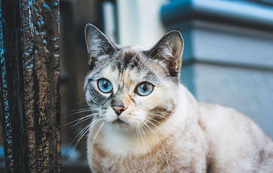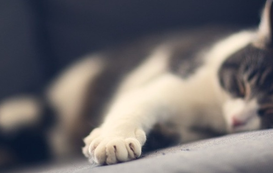Popular posts
Cat Zoomies: What They Are and How they Happen
This post contains affiliate links and Meowtel will be compensated if you make a purchase after clicking on the links.
Ever woken up in the middle of the night to the sound of your cat crashing through something in another room, only to realize they’ve got the late-night zoomies? We’ve all sacrificed our fair share of sleep for our furry friends, but why do these cat zoomies happen, and how can we stop them?
Cat zoomies is a term used to describe energetic outbursts from our cats, where they often sprint around the house, climb furniture, and generally act out. It’s a normal behavior for most cats, especially younger ones that have a lot of extra energy anyways. Trying to understand why the zoomies happen requires us to take a step back and remember that cats are previously wild, domesticated hunters, with all the biological quirks that come along with these facts. It should be no surprise then, that they sometimes have difficulty maintaining their energy levels as effectively as humans.
Whether they’ve caused you loss of sleep, broken items, or simply a few hearty laughs with friends and family, the cat zoomies are a strange, albeit common, phenomenon. Why they happen isn’t completely clear, though most professionals have an idea about what may be behind these feline freakouts. Under-stimulation, sleep habits, and regular routines are a few commonly-related causes as voiced by experts, but the ideas go beyond just those and ultimately depend upon your relationship with your cat and your expectations for how they should behave.
Here are a few theories and ideas about why cats get the zoomies!
Cats need play and attention.
Some associate the zoomies with under-stimulation and the need for play and exercise. This is especially true of young cats with a lot of energy - it’s important to give them lots of attention and stimulation. Cats are natural hunters, so their high-energy is instinctual and should be expected on a daily basis.
You can direct this energy in a healthy way through play, and this should ultimately cut down on any destructive behaviors. The idea is that a cat needs to shed this pent-up energy, and if they’re running around with the zoomies, they’re asking you to play with them more frequently, take them outside on a leash, or do just about anything to help facilitate their energy so that it doesn’t become destructive.
Cats have strange sleep habits.
Many cats sleep on and off throughout the day (and we all know our cat’s sleep schedule can be another topic of difficulty), or they sleep at seemingly random intervals, but there are actually many things owners can learn from the sleep habits of their cat, and its relationship with their energy. It’s not uncommon for a cat to have the zoomies after a long snooze. In fact, it isn’t dissimilar from humans - a cat sleeps when it’s tired, and wakes up when it has the energy to perform its daily tasks.
There are a few things you can do to work with a cat on their sleep habits that will ultimately minimize destructive behavior from cat zoomies, and the next point is a great starting place for that.
Cats thrive on routines and structures.
Many also believe that cat zoomies are related to the routines and structures a cat has throughout their day-to-day. Calming down a crazy cat isn’t always fun, but if we can predict it, we can help direct it through play, outside time on a leash, and the like. For example, many cats are said to get the zoomies right after using their litter box, but if we can establish a routine where they eat at the same times every day (consider buying a timed feeder or just offering consistent feeding times), they’re likely to use the restroom at similar times too, and we can then predict and plan ahead for our response to their madness.
For some, it’s as simple as taking their cats out on a leash right after an outburst, but others may have to address cat behaviors beyond that. Regardless, each cat is different, so trial and error will be a natural part of assessing your cat’s behavior.
Cats will try to tell you if they’re in pain, sick, or otherwise.
Sometimes cats can get the zoomies from health problems, especially if their outbursts can be associated with potty issues or specific traumatic events. For this reason, it’s important for owners to consider a holistic approach to the wellbeing of their cat. Are they acting out in other ways that may be related like potty issues, vomiting, appetite, or other things that may be due to something physically harming them?
If cats are acting strange in any other ways that may be associated with their zoomies, it’s best to simply call your veterinarian, as chronic health issues that cause pain can also be said to cause the zoomies. And at the very least, your vet will be able to offer an excellent set of suggestions for minimizing destructive behavior.
Don’t discipline your cats, distract them!
This is an important rule of thumb in general, but also as it pertains to the discussion on cat zoomies. When your cat is acting out and running around the house, the best thing you can do to limit destruction is to play with them. As soon as you see them exhibiting energetic behavior, distract them with their favorite toys, especially at times during the day that can positively reinforce their energy without punishing them.
If zoomies are, in fact, your cat telling you they want to play, then play is the perfect way to distract them and help shed their energy in a healthy way. This will also help them understand that playing with their toys is a positive way to use up that extra energy and fulfill their hunting needs.
Act bored, and your cat will get bored too.
At other times, facilitating your cats’ zoomies may require an almost opposite response, so this is where context and your own structures with your cat come into play.
If they’re generally getting the zoomies at night, for instance, it may be best to ignore them and let them run around the house. This will both help reinforce the fact that nighttime is for sleeping, and - rather than caving to their attention like you may during the day - they’ll get bored after they’ve relinquished some energy and return to sleeping or relaxing quietly. The other benefit of this is that when you offer them attentive responses to zoomies during the day, they’ll also be able to learn when it’s appropriate to play and act crazy.
Working with your cat for a better household
We all know by now that cats are fickle animals, but this doesn’t mean that we can’t offer them a healthy household. This includes being attentive and loving to them so that we can offer them a safe, stimulating environment in which to grow, as well as offering that to ourselves. When you listen to your cat and try to find out why they’re acting the way they do, you’ll find that solutions for your cat are also solutions for your household. Eliminating destructive behaviors for your cat will greatly enhance your daily life and your ability to bond with them.
As far as our cats’ zoomies go, the best we can offer is a listening ear, and a willingness to keep improving ourselves as their cat parent! Cats are hunters and require some extra stimulation because of it, yet giving in and offering them plenty of play, routine, and attention will surely lead to more snuggly, friendly, and rule-following felines.
Frequently Asked Questions
Q: What specific toys or activities are most effective at preventing or managing cat zoomies?
A: To manage cat zoomies effectively, several toys and activities can be particularly useful. Interactive toys like laser pointers, which simulate the movement of prey, and motorized mice are great for engaging your cat's hunting instincts. Wand toys with feathers or strings can also captivate their attention and provide substantial physical exercise. For solo play, consider puzzle feeders that challenge them mentally while rewarding them physically with treats.
Q: Are there any breed-specific behaviors related to zoomies that cat owners should be aware of?
A: Some cat breeds are indeed more prone to energetic outbursts due to their high energy and playfulness. Breeds like Bengals, Siamese, and Abyssinians, known for their lively and spirited nature, may exhibit zoomies more frequently. These breeds often require more sustained interaction and stimulation to manage their abundant energy effectively.
Q: How can cat owners differentiate between zoomies as normal behavior and when it might be indicative of a health issue?
A: Distinguishing normal zoomies from those prompted by health issues can be nuanced. Generally, zoomies are a normal part of cat behavior, especially in young and active cats. However, if your cat's zoomies seem sudden, more frequent, or are accompanied by other unusual behaviors such as excessive meowing, changes in appetite, or litter box issues, it might be time to consult a veterinarian. These could be signs of discomfort or health issues that need addressing. Monitoring the frequency and context of zoomies can help you decide when they might be more than just playful energy.
Photo by Leon Seibert on Unsplash












